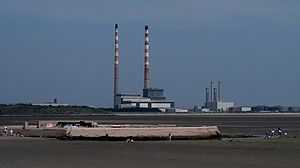Energy in Ireland
Energy in Ireland describes energy and electricity production, consumption and import in the Republic of Ireland. The Energy policy of Ireland will describe the politics of the Republic of Ireland related to energy more in detail. Electricity sector in Ireland is the main article of electricity in Ireland.
This article concerns the Republic of Ireland (Ireland).
Ireland is net energy importer. Primary energy use in Ireland was 167 TWh and 37 TWh per million persons in 2009.[1]

ESB Group, a semi-state electricity company
Overview
| Energy in Ireland[2] | ||||||
|---|---|---|---|---|---|---|
| Capita | Prim. energy | Production | Export | Electricity | CO2-emission | |
| Million | TWh | TWh | TWh | TWh | Mt | |
| 2004 | 4.06 | 177 | 22 | 162 | 25.1 | 41.4 |
| 2007 | 4.36 | 175 | 16 | 165 | 27.3 | 44.1 |
| 2008 | 4.44 | 174 | 18 | 167 | 27.9 | 43.8 |
| 2009 | 4.47 | 167 | 18 | 154 | 26.9 | 39.5 |
| Change 2004–09 | 10.1% | -5.7% | -19.5% | -5.0% | 7.2% | -4.7% |
| Mtoe = 11.63 TWh, Prim. energy includes energy losses | ||||||
Fossil fuels
Natural gas
Natural gas fields in Ireland Include Corrib gas project and Kinsale Head gas field.
Peat
Ireland uses peat as energy which is not common in Europe.
Oil
The Irish oil explorer is Providence Resources, CEO Tony O'Reilly, Junior and among the main owners Tony O'Reilly with a 40% stake.[3]
Renewable energy
Renewable energy accounts for approximately 3% of the Republic of Ireland's energy requirements. The Irish government has committed to increasing this to 15% by 2010 and 33% by 2020. Additionally, Ireland must, under the Kyoto Protocol reduce its greenhouse gas emissions to 13% above 1990 levels.[citation needed]
According to Irish Minister for Energy Pat Rabbitte a new target of 45% renewable energy in the EU by 2030 is realistic to drive Europe out of the crisis to a strong sustainable growth path.(EWEA 2013) .[4]
Wind power
Wind power in the Republic of Ireland is one of the major electricity sources. In the end of 2010 wind power capacity was 1,428 MW.[5] In 2010 the wind power capacity was 320 W/person when the European Union average was 169 W/person.[6]
| EU and Ireland Wind Energy Capacity (MW)[7][8][9][10] | ||||||||||||||||
|---|---|---|---|---|---|---|---|---|---|---|---|---|---|---|---|---|
| No | Country | 2012 | 2011 | 2010 | 2009 | 2008 | 2007 | 2006 | 2005 | 2004 | 2003 | 2002 | 2001 | 2000 | 1999 | 1998 |
| – | EU-27 | 105,696 | 93,957 | 84,074 | 74,767 | 64,712 | 56,517 | 48,069 | 40,511 | 34,383 | 28,599 | 23,159 | 17,315 | 12,887 | 9,678 | 6,453 |
| 13 | Ireland | 1,738 | 1,631 | 1,428 | 1,260 | 1,027 | 795 | 746 | 496 | 339 | 190 | 137 | 124 | 118 | 74 | 73 |
See also
| Wikimedia Commons has media related to Ireland . |
References
- ↑ IEA Key energy statistics 2010 Page: Country specific indicator numbers from page 48
- ↑ IEA Key World Energy Statistics 2011, 2010, 2009, 2006 IEA October, crude oil p.11, coal p. 13 gas p. 15
- ↑ Irish oil find expected to yield 280m barrels of oil, Ireland's first offshore oilfield will yield much more oil than expected, Providence Resources said The Guardian 10 October 2012
- ↑ Fossil fuel subsidies are “public enemy number one” – IEA Chief EWEA 4 February 2013
- ↑ EWEA Annual Statistics 2010 European Wind Energy Association, February 2011
- ↑ Pure Power, Wind Energy Scenarios up to 2030 EWEA April 2008 s. 20–21
- ↑ EWEA Staff (2010). "Cumulative installed capacity per EU Member State 1998 – 2009 (MW)". European Wind Energy Association. Retrieved 22 May 2010.
- ↑ EWEA Staff (February 2011). "EWEA Annual Statistics 2010". European Wind Energy Association. Retrieved 31 January 2011.
- ↑ EWEA Staff (February 2012). "EWEA Annual Statistics 2011". European Wind Energy Association. Retrieved 18 February 2011.
- ↑ Wind in power: 2012 European statistics February 2013
| ||||||||||||||
| |||||||||||||||||
.svg.png)